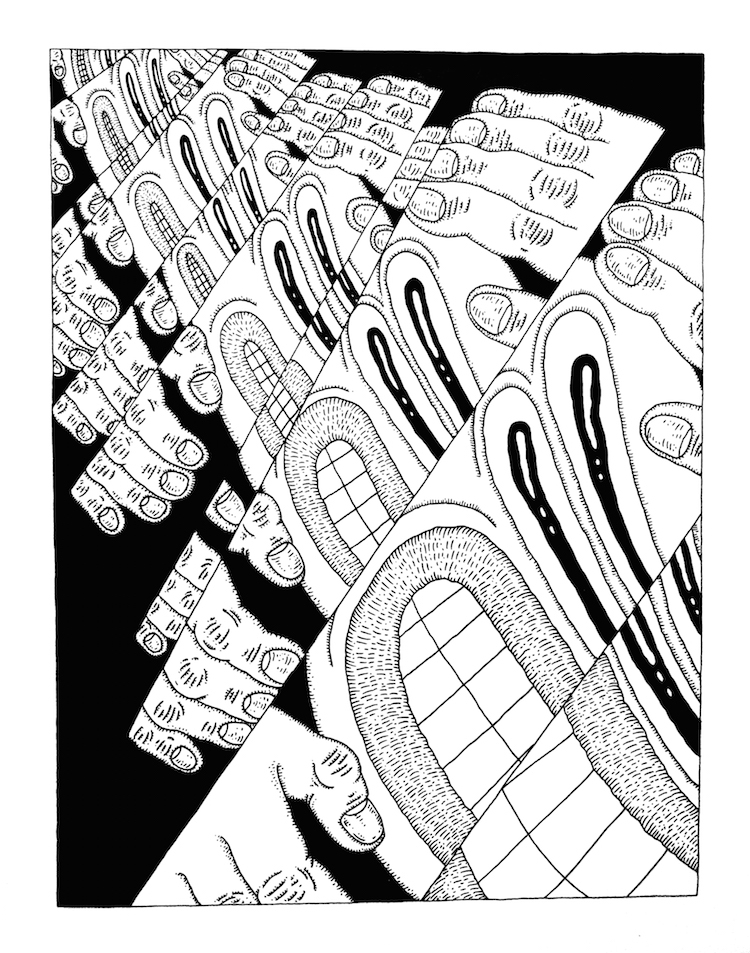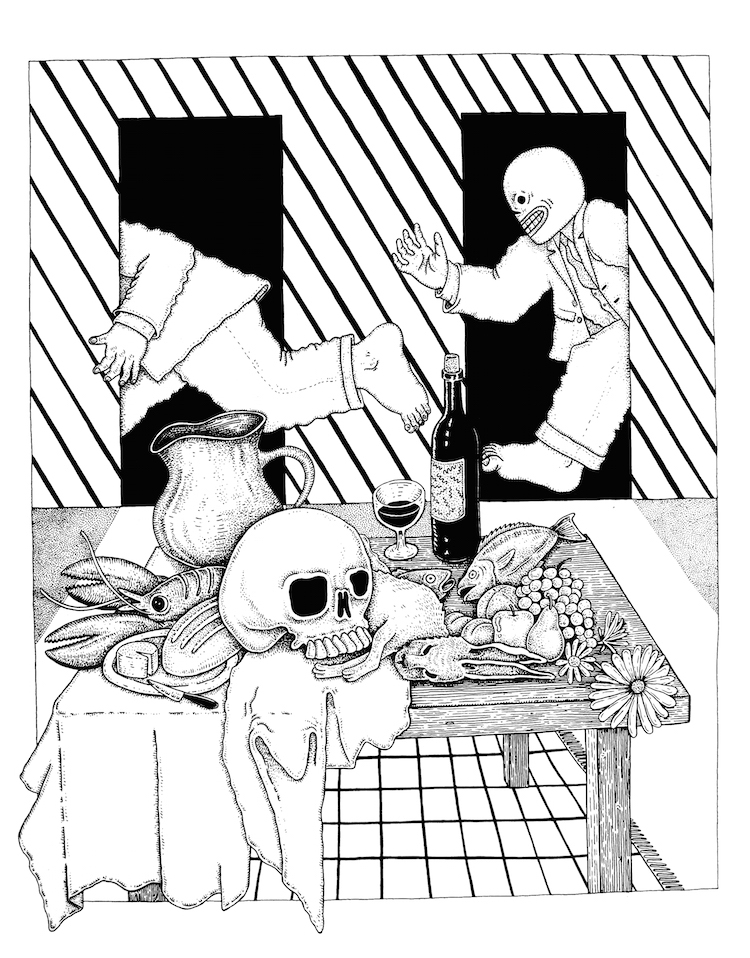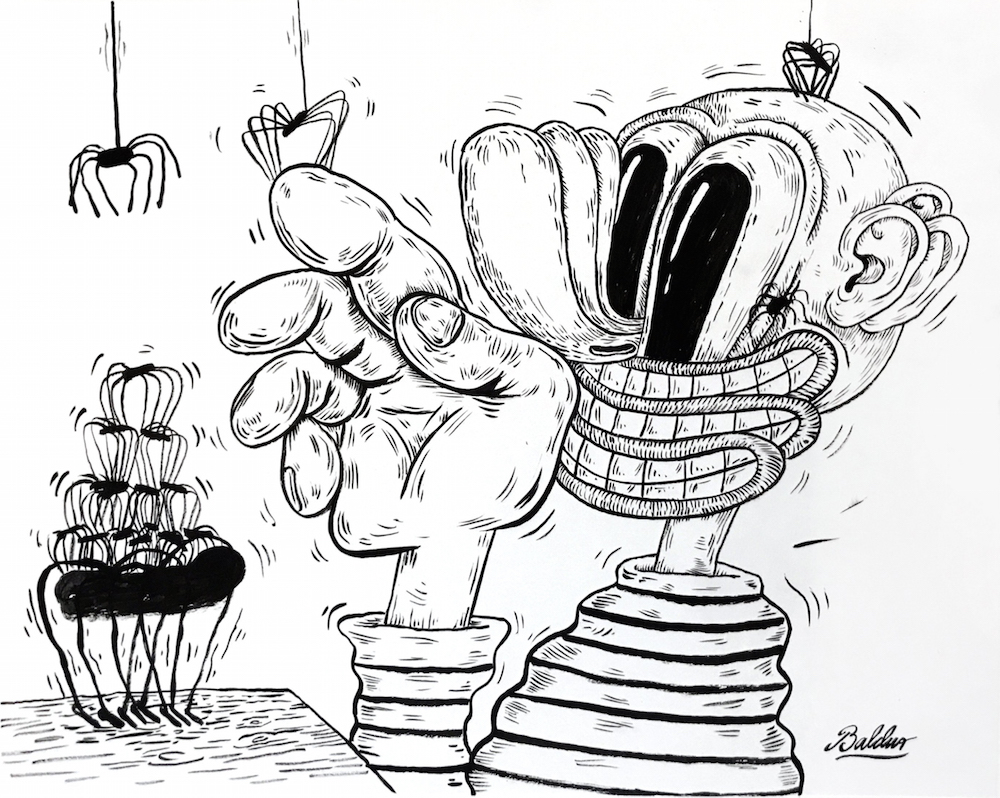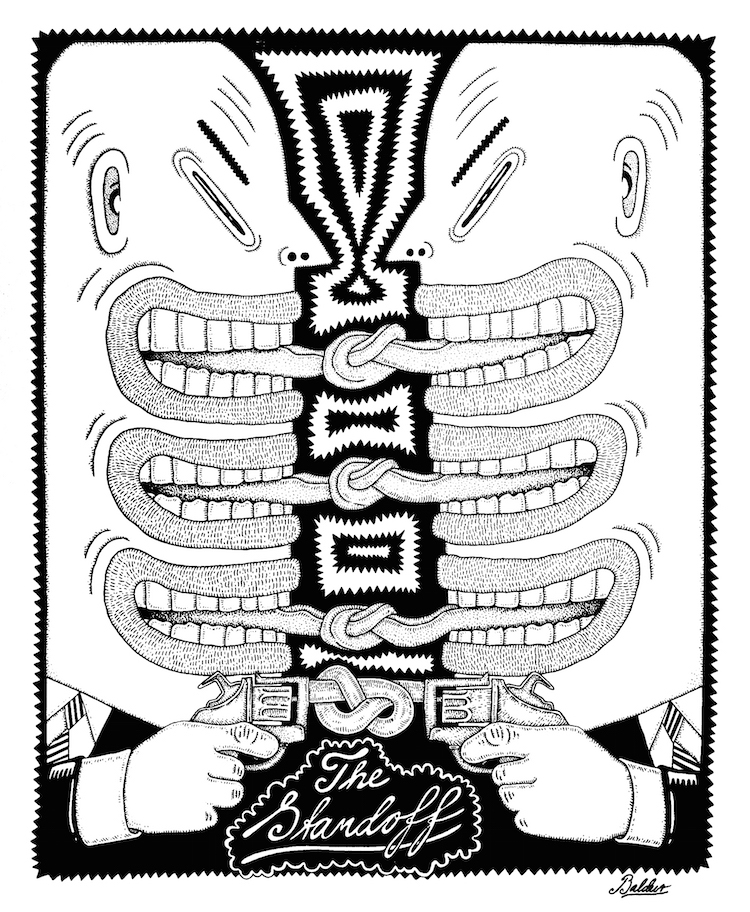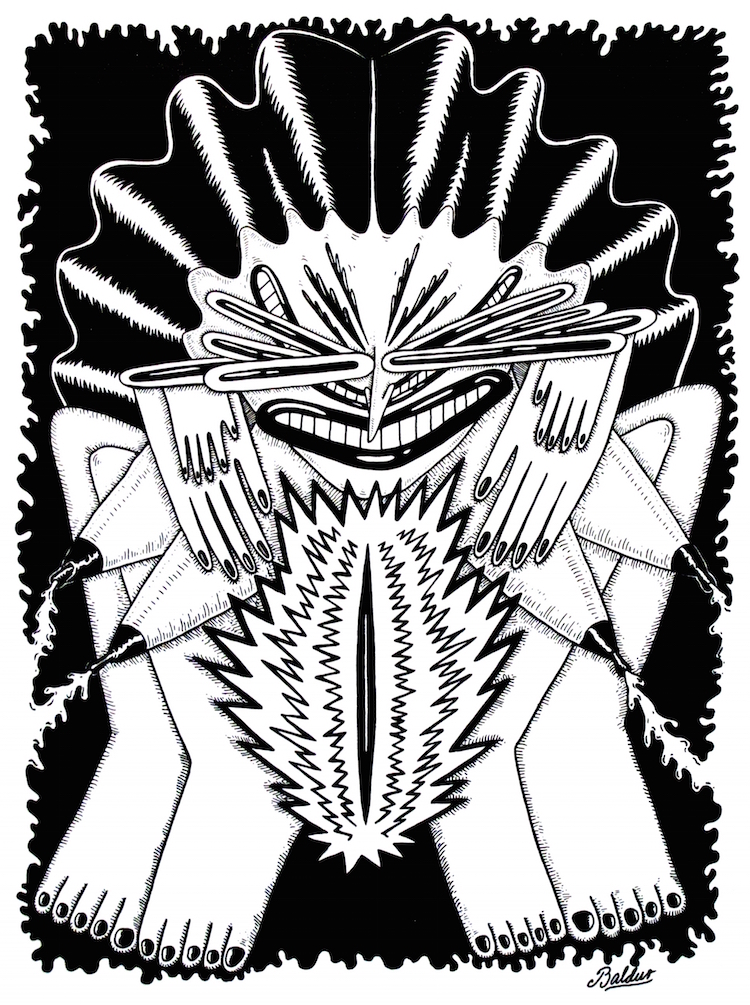Baldur Helgason
ICELAND COMETH
Interview and portrait by Joey Garfield
Baldur Helgason’s paintings take you back to the springy, elastic era of Merrie Melodies cartoons, then bounce further into history with references to the Masters. They also hurdle forward in sardonic references to modern life with both humor and a haunting hit of foreboding. This is the stuff of slightly hallucinogenic dreams and dusty comic books, where figures freeze in exaggerated form, harkening back to an era that he is far too young to be nostalgic for. Well, perhaps not. He’s from downtown Reykjavik. Who knows what influences were common to someone growing up on the isolated island that is Iceland? We do know there’s a strong dose of drollery amidst the self-reflection, but what else lurks within this Nordic native now living in Chicago, armed with a paintbrush and a handful of paint?
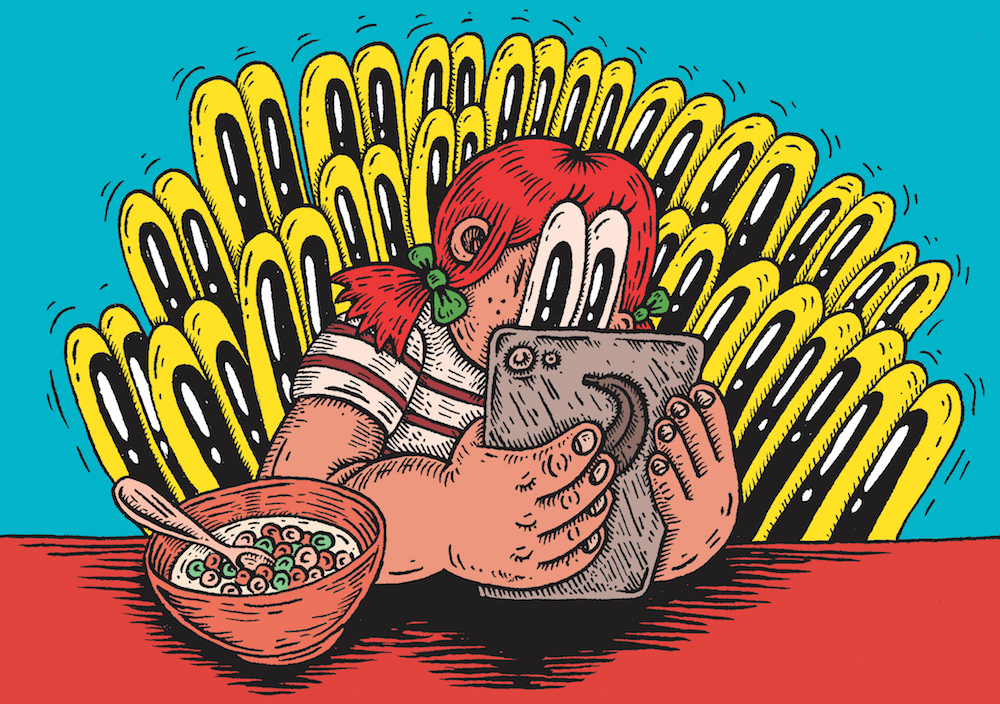
Art Director: Najeebah Al-Ghadban
Joey Garfield: How long have you lived in the States?
Baldur Helgason: I have been living in the United States for eleven years and in Chicago for six. I went to school in San Francisco and met my wife there, but when she got pregnant we moved to Chicago to be closer to her family and closer to Iceland.
So the plan was never to live in Chicago.
No. The plan was to go to art school in San Francisco and then move to Europe and squat somewhere and try to paint. That was the plan.
Seems a little thin.
Ha! Yeah, that was it. Finish school and be a Bohemian in Europe. Drink coffee, drink wine, smoke cigarettes and talk about art with some dead guys who aren’t around anymore. Now I’m here and it’s way better.
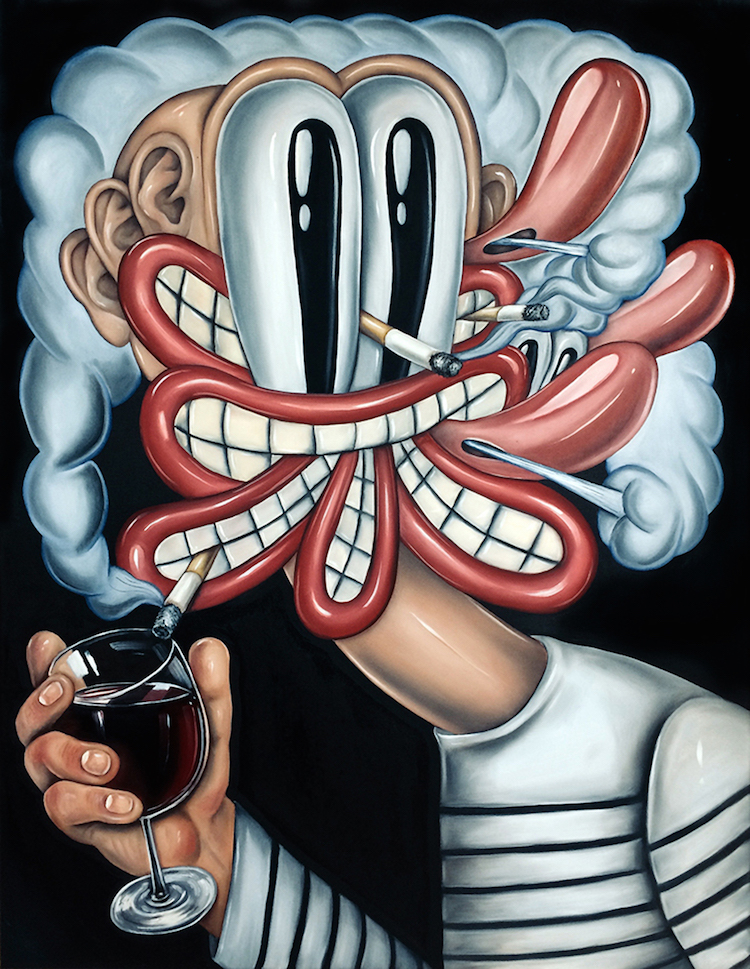
Why San Francisco? Coming from Iceland, that seems like a drastic change.
I wanted a change, I wanted to get a master’s degree. The art schools in Iceland were very conceptually based. You sit around and talk about ideas. They don’t believe in teaching skill or craft in art. San Francisco had a school that was more academic. You paint and draw until you know how to draw the thing. That counterbalance would be good for me. In Iceland, no one showed me how to lay down colors, or what layers to put down to make skin appear cool. Drawing comes naturally to me. I could draw anything pretty perfectly since I was a kid. Painting confused the hell out of me, but that was what I really wanted to do. My first classes were portrait painting classes. I would paint the drawing part with my brush and nail it. I’d get the likeness immediately, but when I would start painting, it was a shit show. I had to have someone show me, “This is how you do it.” Honing that skill helped immensely. And then I figured out a way to paint that worked for me.
So you can draw someone’s perfect likeness if you want, but prefer to make someone cartoon-like? What did you graduate with?
I got a Masters in Illustration from the Academy of Art University in San Francisco. I studied illustration but mostly painted and then showed my paintings as illustrations.
What are similarities and differences between painting and illustration?
With illustration, you are illustrating for the purpose of a story or a newspaper article, and you have a client. With painting, I don’t have to tell a specific story. I can be free in what I’m doing and have it happen on its own. Sometimes, when I have a client, the joy of artmaking dies, but I’ve also done enjoyable stuff for the Chicago Reader, Redbull, and the New York Times. I can do likenesses in drawings or illustrations with a gig once in a while, but painting is my happy place.
This figure who appears frequently in your paintings, with his big toothy smile, seems extremely happy.
It started out as a way of doing a self-portrait without doing a self-portrait. In school, we would have to do what they call master copies, basically doing our best to recreate paintings by the Dutch Masters, Van Dyck, Reubens, Jordaens or Rembrandt.
He emerged when I was doing those Master paintings in school. I was trying to figure out how to put myself in it. I got incredibly sick of painting Master-type realism, and that is when these cartoony figures started coming in. I just took a bunch of my work and started painting googly eyes and big lips on the painted portraits I had already made, and that is how it evolved into this character painting. I would do the technical parts as best as I could, trying to copy the brushstrokes of a master painting, and then I’d put my faces on them. It comes from reading comics when I was little, like Lucky Luke or the Gaston Lagaffe character. It’s a continuation of that but in this smooth, elastic, bend-y painting style that is natural to me. It’s Gaston meets the artist Philip Guston, misunderstood by my hand. I thought it was an interesting idea because we all play this game on social media where we put up these heightened versions of ourselves.
No one at school said this was wrong?
Oh yes! A bunch of them did. There were two teachers who said that I must continue because I was doing something different that no one else was doing. The purist teachers hated it.
Copying the masters is like a blueprint or window into their way of creating? Did you learn a lot from that?
Yeah, because I would screw up what they did, and then have to figure out what exact brush they used or how they blended. But it was purely technical. I wish I got some kind of holy spirit of Edvard Munch telling me I should be as miserable as he.
Well, this guy isn’t miserable. He has a playful, mischievous quality.
Yes, and there’s some mania in the face of these guys. I do find myself making the face of the character when I paint.
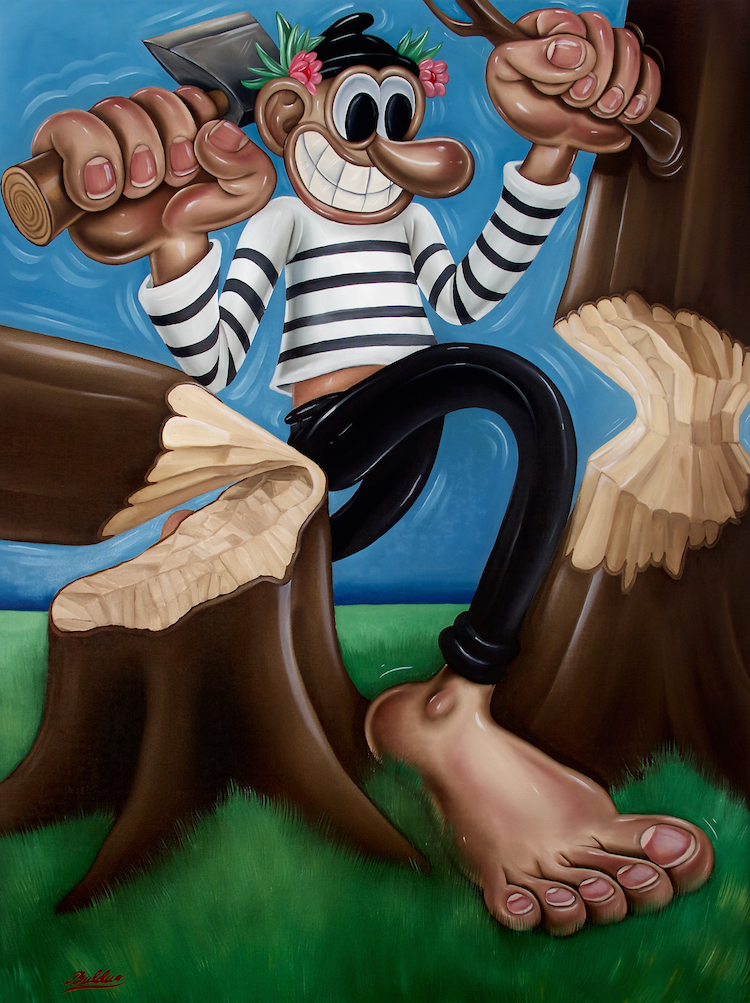
Do you talk to this guy or hear a conversation when painting him?
Only me judging myself. I will have audio playing in the background, so that drowns out the conversations in my head because they get in the way. If not, I ask myself why I put this line here...
There seems to be a theme with him wearing striped shirts.
Well, that’s me. That is my uniform. You’ll almost always find me wearing a striped Breton-style shirt. I started wearing them when I was in art school in Iceland to look Bohemian. I read once that Andy Warhol wore striped shirts because Picasso wore striped shirts, so that’s what artists do. I like how the simplicity of a modest garment signifies you’re an artist. People make fun of the fact that I wear them all the time. So when I started playing around with this alter-ego/self-portrait figure, that had to be a part of it.
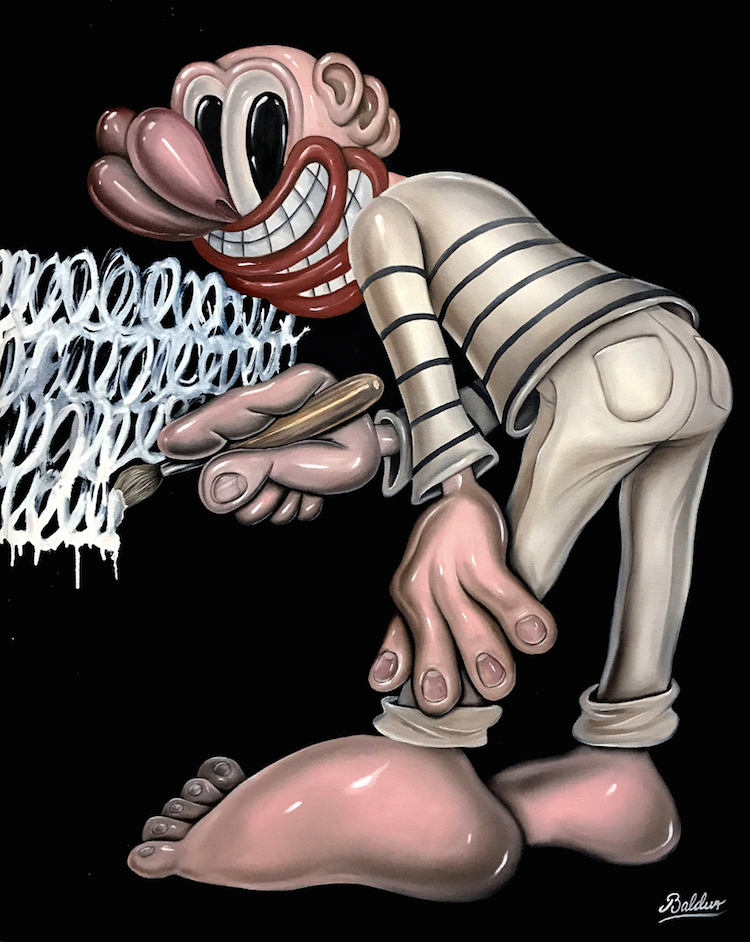
He seems to be a strong smoker, has he considered vaping?
He hasn’t vaped yet, but he’s quitting very soon.
What’s with the multiple facial features, and hands, and skin theme? It’s trippy.
It's fun to paint hands. It's what I draw or paint when I’m not thinking. Hands do all the work. When I paint, I add body parts to make the balance of the painting work better for me. It also works to off-balance if it’s too structured. The skin started while studying in school. It is in the Master style of painting skin tones. Like Rembrandt or Sargent, it’s a limited palette which I had used then and still do, though now its for these cartoony figures.
Can you expand on how you use this limited palette?
Limited palette means that you limit the amount of colors you use. I mainly use Titanium White, Mars or Ivory Black, Burnt Umber, Cadmium Red, Indian Red, Yellow Ochre, and Ultramarine Blue. It started with what they call the Zorn palette, but evolved to my taste. The more you work with a limited palette, the more you gain control. I really like the color harmonies I get with those colors. It’s also very handy when I’m traveling and I want to work remotely, I don’t have to pack too much.
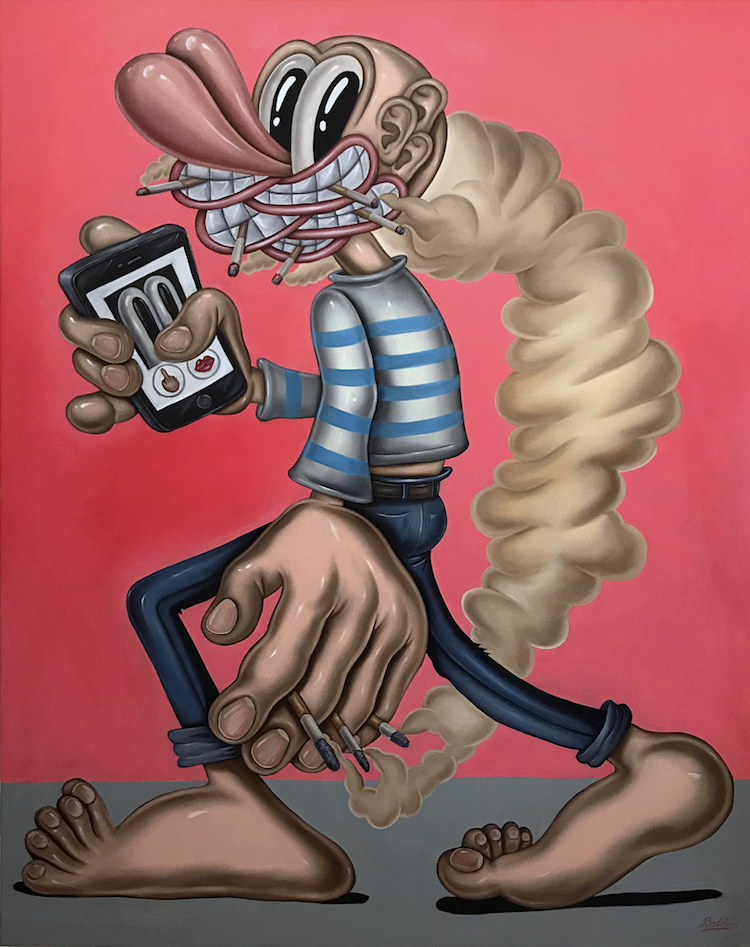
You only use a handful of colors to make all these paintings?
Yes, from those colors, you can pretty much get whatever you want.
It seems like this illustrative realism style is free and loose, but also very time consuming.
Yes, it is. You have to be open and not too specific. For instance, I am making this painting of a guy painting a wall. He is painting messy, but I can’t just splatter paint in this painting, I have to paint the splatter of paint he made. It can’t be something more specific than the action of painting either.
Is there a difference in approach when you do your pen and ink work versus painting?
There’s definitely a different energy. When I sit down and do a pen-and-ink drawing on paper, it’s more of a quiet, meticulous act of art making. I get fixated on little details and it takes way longer. It is a quieter act of art making, more meditative, I guess. When I paint, I like a bit more chaos. I put on music, and at the same time, I’ll have a cooking show playing in the corner or videos of “artists in the studio.” It’s nice to have the illusion of other people getting work done in my studio. But it is a messier, looser atmosphere when I’m painting. More extroverted. I will also jump from painting to painting, but with the drawings, I weirdly have to finish them one at a time.
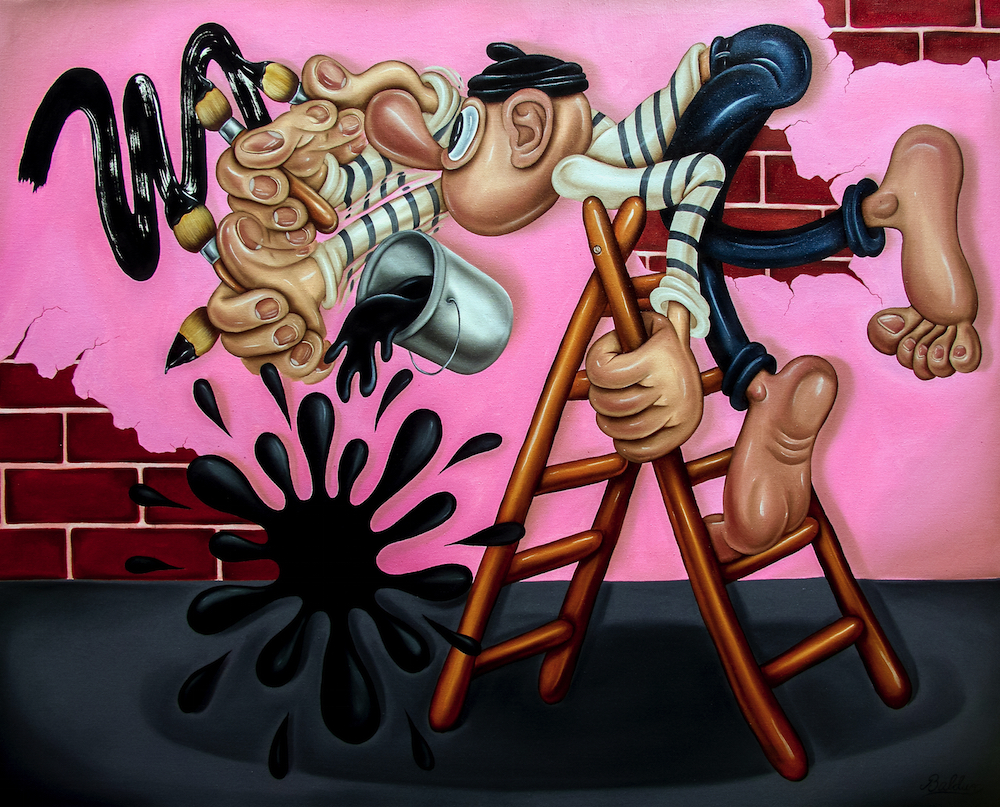
There is a quality to your style that reminds me of that early rubber hose animation, like Otto Messner, who drew Felix The Cat, or even Popeye. It’s a bouncy, elastic, old-school vibe.
I grew up watching these Russian Cartoons. The Soviet Union was putting a lot of money into cartoons to compete with the US, so the government-funded these incredible cartoons. There was this one of a rockabilly fox who smoked cigarettes. I would draw that all the time. A lot of my stuff is referencing mid-century European cartoons and comic books, which were influenced by those early American cartoon styles like Betty Boop. That stuff that bounces, I think, it is the loop that made them move like a rubber hose.
Do you still read comics or watch cartoons now?
I watched the SpongeBob movie with my daughter but I don’t put on cartoons. I loved Ren & Stimpy when I was a kid.
You had Ren & Stimpy in Iceland?
We started getting American channels on TV when I was a teenager with cable like Cartoon Network. Ren & Stimpy did a Böjrk video.
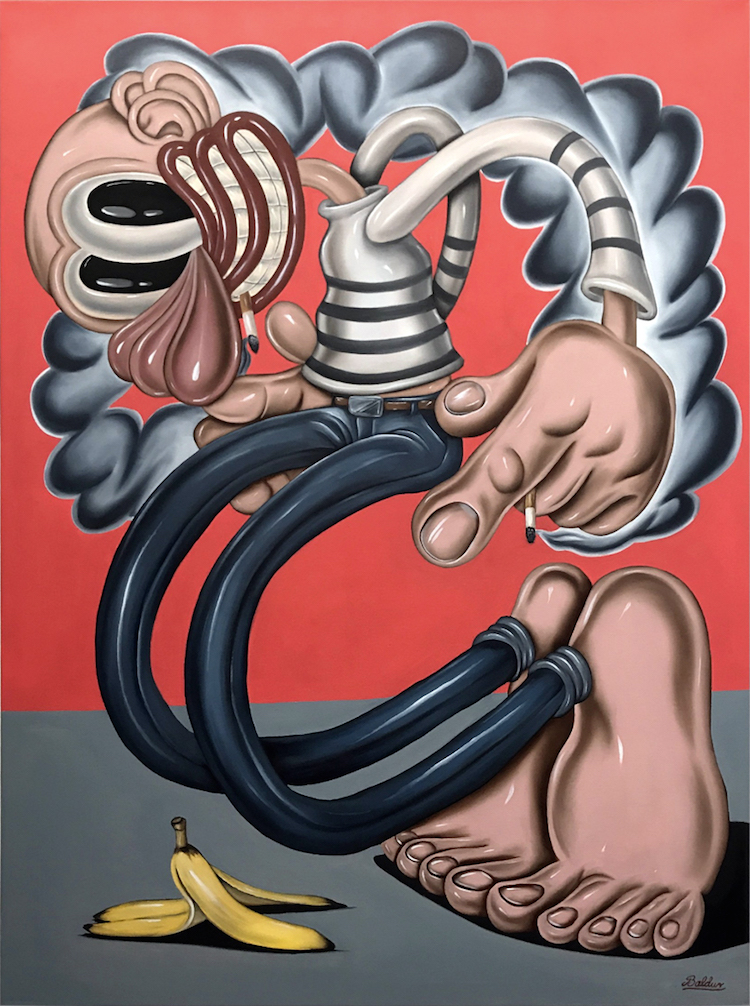
They did? Are you a fan of Björk’s?
Of course! She is like the Queen of Iceland. She is the reason why anyone knows about Iceland. She was the first to breakthrough with something creative or artistic, and it opened up the idea in Iceland that if you do something good, it could go international and people could like it. She was the first one.
So have you reached a point where you are happy with where you are now? Are you at a place where people are receiving it well?
In the last year, people have been showing more interest. When I moved to Chicago, I didn’t know anyone. I emailed galleries and didn’t hear back from any of them. But John Maloof opened a gallery in Skokie called Mishkooki. He was the first to show me here, and then a chain reaction started. I made a series of work for Galerie F here in Chicago, and I’m going to be in London, as well as a group show in Amsterdam with artists I really love. Then back in Chicago for a November show at a place called Niche in the Pilson neighborhood.
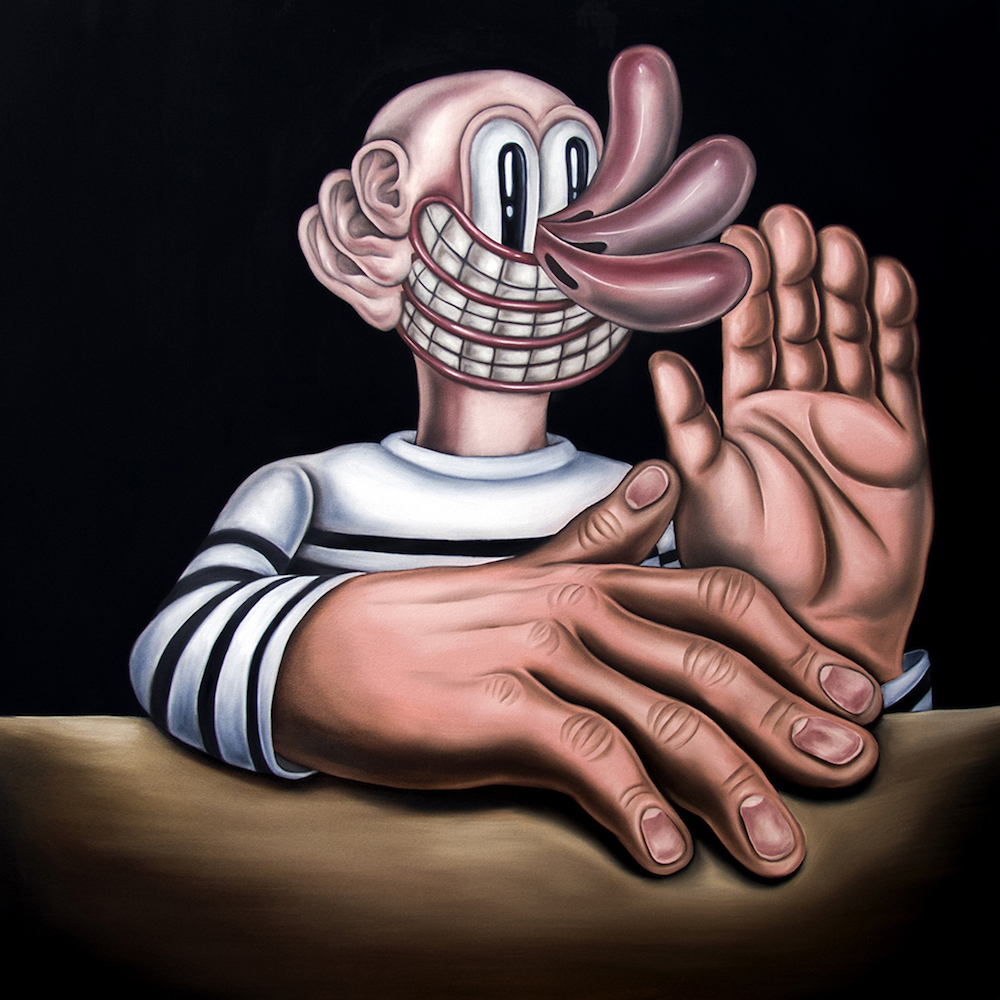
Had you heard about the Chicago Imagists known as the Hairy Who? They started in the early 1960s at the Art Institute Of Chicago and became an influential art collective.
I hadn’t, but John Maloof mentioned that my work reminded him of them. I had just heard about the Hairy Who the week before he said that! So when I looked it up, I was like, “Ooh, I am in the right town. This is the perfect spot. There is a precedent for this illustration style of fine art in this city.” They would probably be furious to call it illustration but it is in the family. They were doing comic books and prints. There was an international movement around the world at that time. It was different from the pop art that was around, but their work was in the Zeitgeist, in the ether. It is incredible that they were kind of ahead of the New York Pop artists, or at least around at the same time. It has aged incredibly well.
What will you be doing for this new run of shows?
For my upcoming show, I am sketching the work out in a book and then I transfer the sketch to the canvas, which I usually don’t do. These are a set of ideas in charcoal drawings put on canvas. I was in Iceland and didn’t have a place to paint, so I was just flipping through art books, stealing ideas and drawing down which way I would have done a certain painting, then translating those ideas into these paintings.
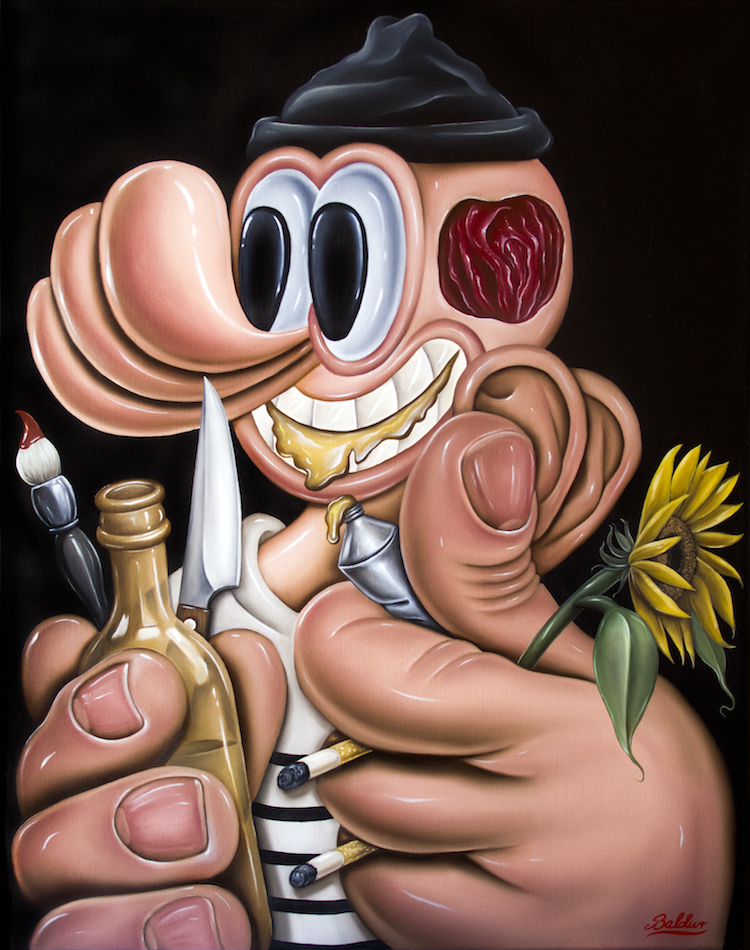
Like, “Van Gogh is cool, but he should have done it like this”?
Exactly, but I’m going to mess it up better! I hope people will recognize that.
So why do you want to reference this character in other classic paintings with your work?
That bohemian nostalgia I mentioned earlier is the reason for placing him in different art eras and styles. The paintings are filled with references to paintings and philosophy. The comic book character is a superficial front of what the paintings are trying to explore. It’s my way of having a dialogue or involving the Old Masters and art history, and he gives me the opportunity to work with different styles and art movements. So he’s visited Symbolism, Minimalism, Surrealism, and Expressionism, to name a few. It often depends on what books I have laying around at any point in time.

So if this character is a reflection of you, are you able to be self-reflexive or see current moods?
Like any Nordic artists, I think the stereotypical “Scandinavian pain” is certainly present in the work; it’s just hidden behind that manic smile. He’s an exploration of my psyche, but recently he’s becoming more of an exploration of the western world’s obsession with materialism. There have been a lot of flowers and plants in recent paintings. First, he admired them, then started picking a few flowers and decorating himself. Now he’s covering himself in them and cutting down entire forests. I guess it’s my not-so-veiled panic about climate change. I was getting bummed out about it. Us being horrible people.
The human subject is very complex. The world is now in an identity crisis on how to be or not be assholes.
Yeah, we applaud it.

How do Americans seem to you?
I have been living in an incredible bubble. Chicago and San Francisco are two of the top five most liberal cities in America. I do like you guys. Culturally, your sense of humor is different from dark, weird Icelandic humor. I’d panic in class because I’d say something that would have killed in Iceland, but here they think I meant it and I’m an idiot. The Nordic dry humor had to get cut out of my life to survive.
So, are you acclimated?
I am becoming more American. I have an American wife and kids. When I went back to Iceland, I couldn’t speak. There are hardly any Icelandic people in Chicago or San Francisco, so the brain switch is more difficult. I dream in English now.
How does Iceland feel about your work?
I’ve had two shows there in the last four years. I think they went really well and they got a good amount of press. The folks that came to the shows seemed to like it, or at least were kind enough to pretend to like it.
Balder Helgason will open Tender at Padre Gallery in NYC on January 23rd.
www.baldurart.com


